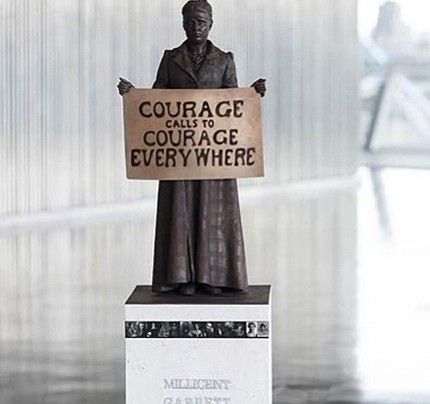All the statues in London's Parliament Square were men -- until now
CNN/Stylemagazine.com Newswire | 4/24/2018, 7:36 a.m.
By Sheena McKenzie, CNN
(CNN) -- The 11 statues of male historic figures dotted around Britain's Parliament Square had a new addition Tuesday -- Millicent Fawcett.
The suffragist, who campaigned for women's right to vote at the turn of the 20th century, will be the first female to be honored with a statue at the site opposite the Houses of Parliament in central London.
It will also be the first statue at Parliament Square designed by a woman -- British artist Gillian Wearing.
The statue of Fawcett, who helped found the National Union of Women's Suffrage Societies in 1897, will stand among other historic figures including Winston Churchill, Nelson Mandela and Abraham Lincoln.
The statue comes after almost 85,000 people signed a petition from feminist activist and journalist Caroline Criado Perez to get a statue of a woman in Parliament Square.
Perez's previous campaign to have a woman on British bank notes, resulted in the Bank of England agreeing to picture "Pride and Prejudice" author Jane Austen on every £10 by 2017 -- which earned Perez a barrage of social media abuse.
However, Perez says she remained determined to see the Fawcett statue through to completion, with the plinth also bearing the names and pictures of dozens of women and some men who contributed to the suffrage movement.
"This makes the statue yet another first: It will be the first statue in Parliament Square to deviate from the Great Man version of history," Perez wrote for CNN.
"The first statue to acknowledge that change doesn't come from one man alone. The first statue to acknowledge that while movements may need leaders, those leaders are nothing without the people who fight alongside them."
Fawcett's suffrage movement used non-violent methods to campaign for equal rights for women, as opposed to the more radical suffragettes known for their extreme tactics of hunger strikes, arson and chaining themselves to property.
In 1866, at the age of 19, Fawcett collected signatures for the first petition demanding female suffrage to be handed in to Parliament. In 1928, she was up in the Ladies' Gallery in the House of Lords watching the Equal Franchise Bill being passed.
She died a year later in 1929. Until now, not a single public statue of her has existed.




